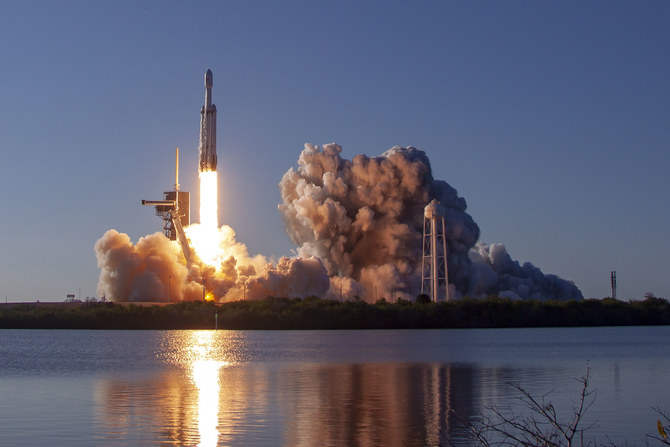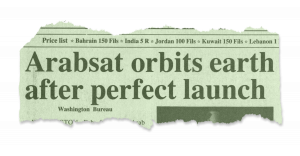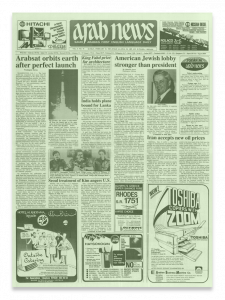- ARAB NEWS
- 02 Jul 2025

Nidhal Guessoum
Arabsat-1A marked the start of the region’s burgeoning space age
Summary
On Feb. 8, 1985, the first Arabsat satellite launched into orbit aboard a French rocket, marking the Arab world’s entry into space. While Arabsat-1A malfunctioned, it was soon followed by Arabsat-1B, deployed by Saudi Prince Sultan bin Salman on his historic trip to space aboard NASA’s Discovery shuttle.
Arabsat’s telecommunications satellites now carry hundreds of television and radio channels to the region, while the region’s space programs play essential roles in urban planning and military surveillance. With billions of dollars in investment, the field of space science and technology has become an essential field for growth in the region, as Arab countries plan missions that will reach across from the international space station to Mars.
Sharjah, UAE: The current Arab space age can be credited to Arabsat, the pan-Arab satellite communications organization. In February 1985, Arabsat launched the first of a series of satellites (16 over the next 35 years). By 2020, the Arab world had at least six space agencies, dozens of satellites (some replacing others over the years), three astronauts who have spent time on space stations, and a probe that will soon go to Mars.
Arabsat is known mostly for satellites that carry hundreds of television and radio channels covering the Middle East, half of Africa and most of Europe. But, in addition to the various space communications services it provides (including satellite telephony and broadband internet), Arabsat should be known as a pioneering and hugely influential organization. It was founded in 1976 by Arab League states and it started to launch geostationary telecommunication satellites in February 1985. Saudi Arabia and Kuwait hold slightly more than half its shares (36.7 and 14.6 percent, respectively), while the rest is held by 19 other Arab states.
We can refer to 1985 as the Arab world’s (first) year of space, with the launch of Arabsat-1A, which unfortunately malfunctioned but was quickly replaced with Arabsat-1B, the latter being launched during the historic trip of Saudi astronaut Prince Sultan bin Salman aboard NASA’s space shuttle.
In the three decades that followed, Arab states established space agencies (from Morocco in 1989 to the UAE in 2014) and launched many satellites, for either collective or country-specific purposes, mainly telecommunications or remote sensing. Iraq was the first Arab state to launch a satellite for itself (in December 1989), becoming the 10th nation in the world to have one in orbit.
Arabsat, largely funded by Saudi Arabia, is founded by 21 member states of the Arab League, with its headquarters in Riyadh.

Arabsat-1A, Arabsat’s first satellite, is launched by a French Ariane rocket from a base in French Guiana.
Arabsat-1B launches aboard NASA space shuttle Discovery, along with Saudi Prince Sultan bin Salman, the first Arab, Muslim and royal in space, who successfully deploys it a day later.

The UAE launches KhalifaSat, the first satellite built entirely by Emiratis.

The Saudi company Shammas announces that it will fund the Kingdom’s first privately owned satellite, BadrSat.
SpaceX launches Arabsat-6A with the world’s most powerful rocket, Falcon Heavy, in what is the rocket’s first commercial launch.

Arab space efforts took a quantum leap in 2014, when the UAE announced plans to build a probe to Mars, which is scheduled to launch in July 2020. In 2018, it launched KhalifaSat, the first high-resolution remote sensing satellite to be fully constructed by Emiratis. Then, in 2019, it sent an Emirati astronaut, Hazza Al-Mansouri, to the International Space Station — the first Arab to go to space since 1987 and only the third in total. Other space achievements, albeit smaller, have been made in the region: Universities and research institutes have built CubeSats and had them sent to space; Saudi Arabia contributed to a lunar communications relay satellite that was launched in support of the Chinese Chang’e-4 mission to the far side of the moon; and a private Saudi company, Shammas, inaugurated BadrSat, the first Saudi satellite owned by the private sector.

“The Arabsat system will provide improved communications to all 22 Arab countries with over 8,000 telephone circuits, and eight regional and domestic television channels, including a community television channel.”
From a story by Arab News’ Washington bureau on the front page, Feb. 10, 1985
Space science and technology has become an essential field for countries seeking to develop their infrastructures and human resources in various areas, including academic, technical and economic. Arab states have understood the strategic nature of space and have invested millions or even billions of dollars in various programs.
In addition to information and telecommunications, there are a number of strategic, educational and commercial benefits to space science and technology programs.
Strategically, governments must monitor their lands for both natural and human activity, ranging from environmental changes to illegal activities such as smuggling, not to mention military actions.
Educationally, when involved in space projects, students learn to design satellites and instruments and tackle current problems by using the rich data that one can obtain with satellites. Furthermore, the skills that students acquire through such projects can serve them in a wide range of careers. The burgeoning Arab space age needs a broad base of young experts and enthusiasts who tomorrow will be innovating in both basic and applied space research. This requires the engagement of a whole ecosystem of institutions of various kinds.

Commercially, satellites can provide high-definition broadcasts, broadband internet and telephony, real-time imaging of special events or actions (including search and rescue operations), and many other profitable and/or critical ventures. A number of space organizations, including some in the Arab world, have started to compete in this arena.
The next major milestone that the Arab world, especially the Gulf region, will need to reach is the building of a launch facility, from where rockets carrying satellites and probes can take off. While six Arab states have established space agencies or institutions and some of them (Algeria, Egypt, Morocco, Saudi Arabia and the UAE) operate their own satellites, none have space rocket launch capability or astronaut training facilities.
The Arab world must pool its financial and human resources to pursue and execute next-generation space projects
Nidhal Guessoum
Such efforts and facilities could be set up regionally. Indeed, calls have been made for the creation of a pan-Arab space agency — similar to the European Space Agency — to coordinate and operate new, ambitious and collective programs. Such a regional agency would help reduce the costs of satellite and probe construction, launch and operation, as well as train astronauts and young experts.
The Arab world should follow its own Arabsat example, when it worked collectively to provide satellite telecommunications to 21 states. Now it must pool its financial and human resources to pursue and execute next-generation space projects.
Space programs (technology and exploration) have much to offer to the Arab world at this juncture of its scientific, technical, economic, educational, and cultural development. Space programs now play essential roles in urban planning, land observations and uses, military surveillance, etc. More intangibly, space programs give a nation geopolitical prestige and — quite importantly — inspiration and education avenues for its youth.
Arabsat was a big success in various ways. Now is the time for the Arab world to follow up that achievement by collectively setting a clear, multi-faceted and future-looking space strategy.